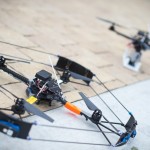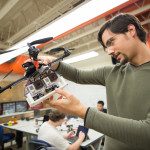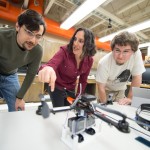Elizabeth Basha, University of the Pacific – Non-Military Drones
Unmanned aerial vehicles, more commonly referred to as drones, have been in the news a great deal lately – and the news is usually very negative.
Elizabeth Basha, engineer at University of the Pacific, is working to show the positive use of drones.
Elizabeth Basha began her work with wireless sensor networks while a Ph.D. student at MIT, but she returned to University of the Pacific, where she had earned her bachelor’s degree, to teach.
“I decided I wanted to teach (rather than go into industry), and at a place where teaching was really valued,” said Basha, an assistant professor in the School of Engineering and Computer Science at Pacific in Stockton, Calif. “It’s fun to teach students how to think about problems and focus on the bigger picture.”
For Basha, the “bigger picture” means applying engineering concepts to societal concerns, such as developing sensor networks to monitor for bridge safety and to detect natural disasters, such as floods, earthquakes and landslides.
“I like to explore new frontiers and find ways of combining engineering systems with helping people,” she said.
Basha’s interest engineering stems from her enjoyment of high school mathematics and her father’s encouragement to try engineering. She became interested in sensor networks and international development through a course at MIT where she and other students traveled to Honduras in January 2004 and the community partner there requested that they develop an early warning system for flooding in the region. The students didn’t know how to put together such a system, but wanted to help. Two years later, Basha switched her research area from computer architecture to sensor networks and robots to use the flooding project as part of her Ph.D. Here is a link to a 2005 video that explains the project in more detail. [link]
Basha joined the Pacific faculty in 2010 and her research interests include sensor networks, robotics and international development. Her teaching interests include sensor networks, robotics, computer architecture, and digital design, and she uses her research as examples to students when discussing applications of the sensors.
Basha received a $100,000 National Science Foundation grant for a project in collaboration with the University of Nebraska, Lincoln, to investigate the use of aerial robotics to wirelessly transfer power to maintain sensor network systems. The project includes building the power transfer system, developing algorithms for selecting nodes to recharge on the unmanned aerial vehicle and sensor network, and extends power management solutions on the sensor networks.
Undergraduate and graduate students have been involved in this ongoing project.
Basha graduated from University of the Pacific in 2003 with a B.S. in computer engineering. She received her M.S. in 2005 and her Ph.D. in 2010, both from MIT and both in electrical engineering and computer science.
Non-Military Drones
![]()
Too often we wrongly lump unmanned aerial vehicles, or UAVs, with military drones. Or we hear about UAVs in the news when one flies too close to the flight path of a commercial jet, or onto the White House Lawn.
Amazon.com wants to use UAVs to deliver packages, and restaurants hope to bring tacos and pizzas to your door using UAVs.
But when you think about it, UAVs can be a great tool for making a real difference for us all.
For example, our nation’s infrastructure is crumbling and in need of repair. In the future, we will be able to place wireless sensors on bridges to monitor them for safety. But how do we keep those sensors powered? We fly UAVs to the sensor nodes and charge their batteries remotely, that’s how.
Researchers are using UAVs to collect water quality readings, check on crops, and forecast landslides, floods and earthquakes. They are used to deliver medical supplies, food, and water to areas cut off by natural disasters. We can use them to monitor environmentally sensitive areas so researchers don’t have to stomp through those protected spaces.
UAVs are even being used to deliver medicine to a remote island off the coast of Germany.
My students and I are using UAVs to vastly improve data gathering from underwater sensors. We can show that UAVs can fly to sensors that float to the surface, collect the data, and improve communications with other nearby sensors by 154 percent. That’s a big deal.
Yes, there is mischief possible with UAVs, but there is far more good that can be done using these fantastic flying tools.









